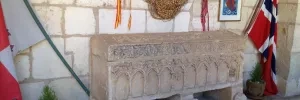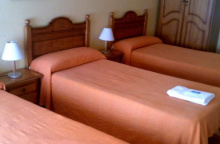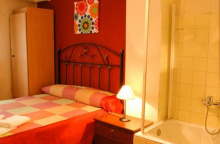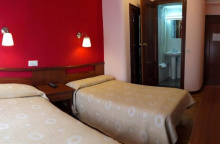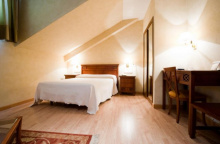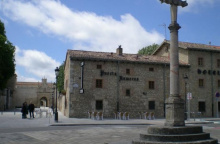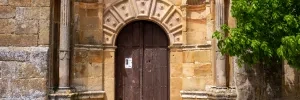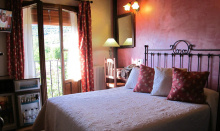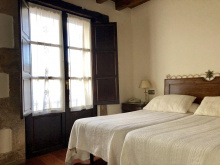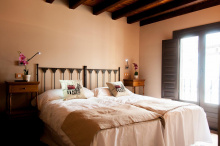This guide was initially written by Alf Alexander Pedersen (@alexwalker) and provided to the pilgrim community via the Camino Forums.
He has generously shared it here so that it can be published as a mobile app for pilgrims, who can in turn submit their observations for future editions.
You are encouraged to use it, and to help keep it up to date by submitting your observations via the app, via email, or in the forums.
INTRODUCTION
The way of San Olav is an easy 3-day walk from Burgos to Covarrubias in Spain, to the tomb of the princess Kristina of Norway.
On purpose, I have named this guide “A Walker's Guide”, since this route is not a pilgrimage as such; There is no saint or holy place at the end, only the tomb of a Norwegian princess, 800 years old. But it is a nice, tranquil and easy walk thru pleasant and undisturbed landscapes in rural Spain.
A nice break from the noise of the Camino Frances, if you want a couple of days in solitude. No bed race here...
GETTING A CREDENTIAL, MAP & INFO
The Tourist Office in Burgos can supply you with a credential containing space for sellos, and route info, and a brochure containing a map; all with glossy paper, so you'll need to let your sellos dry for a few minutes.
Note that some of the information in those papers may not be totally correct/updated (see more further down in this guide), but all in all, together with this guide, you should have no problems getting there.Some
SHOPS & WATER
There are no shops on this Camino. The villages are small, so you eat in your Casa Rurales, have them prepare your breakfast/lunch, and eat some in the bars that exist. If you need more, you buy it in Burgos and carry it. Always carry enough water, as I only found 2 working fountains.
LANGUAGE
You will need some basic Spanish, at least for booking, directions, foods, etc. Also, by being able to communicate at basic level at least, your walk will be much more enjoyable, IMHO. There is no much understanding of English in rural Spain.
ALBERGUES & ATM
There are no albergues on this Camino, only Casa Rurales. And no ATMs until Covarrubias, but bring enough cash for drinks, food and Casa Rurales.
OTHER RESOURCES ON THE INTERNET
There is an interesting and informative piece of info regarding the route and its surroundings obviously recorded by another walker on the website Wikiloc.com.
The tourist office in Covarrubias has a website in Spanish only.
The San Olav chapel hasits own website with info on opening times etc. All is in Spanish, but the keepers are Norwegians and will understand English if you use their contact form. Check opening hours. E-mail address: info@capilladesanolav.com
The world's largest English-speaking forum on the different Caminos in Spain is www.caminodesantiago.me/community. It has a separate section on El Camino San Olav. Ask and get answers there.
There exists a nice website for this Camino in English, Spanish & Norwegian. Very good descriptions of the villages en route, and a good map service, but not always precice regarding the route and stopping places. However, very interesting, and complementary to this guide.
PLANNING TIPS
This will normally be a 3-day walk. The chapel is open only on Saturdays and Sundays, so if you start from Burgos on a Thursday or Friday, you will be able to attend to the Sunday sermon. Check beforehand if there actually is a sermon the actual Sunday. Also,the church in Covarrubias with the sarcophagus with Kristina is, is closed on Tuesdays.
WAYMARKERS
The way is normally marked with dark poles, some red painting and a San Olav cross on top. They are not big, so keep your eyes open. A few of them have been stripped of the San Olav cross by what we must call “touristigrinos”, but the red paint is still there to follow. You will also find some stone markers. Just follow the San Olav cross.

Burgos was originally founded at the end of the 9th century in a bid to repopulate these northern plains. From the expulsions of the Muslims (around the end of the 11th century) it quickly became one of Castilla’s most important city. It was here that the Catholic Kings Isabel and Ferdinand welcomed home Christopher Columbus after his second voyage to the new world, and it was here where General Francisco Franco was publicly proclaimed as Generalísimo in 1936 and which would serve as the dictators base of operations until the end of the civil war.
Set along the wonderful río Arlanzon, the city was built with massive walls and even more massive gates. In spite of this, the territory of Burgos (but more to the point Castilla) was widely disputed. The seed for much of the fighting was the will of King Fernando-I, who although wise enough to rule over the northern regions, was not too clever in managing his estate. He chose to divide the north into three regions upon his death, with each region going to a different heir.
Alfonso VI received León, García received Galicia, Sancho II received Castilla, and his daughter Urraca received the city of Zamora.
More land disputes followed and in the end it was Alfonso that reigned over the whole territory and was crowned the emperor of the Iberian Peninsula. This was at the end of 11th century, and the wealth collected by Alfonso from tariffs throughout the peninsula was transformed into palaces and a Cathedral, catapulting Burgos into prosperity.
Burgos is also the home of El Cid, a fierce warrior, and cunning politician. He was banished from the city by King Alfonso for having forced him to take an oath attesting to his innocence in the death of his brother Sancho. El Cid would eventually turn down an invitation to return and fight for Alfonso, and instead traveled east to Valencia where he maneuvered himself into a kingdom of his own. He is now buried in the Cathedral.
With such a long history it should come as no surprise that the fiestas and festivals celebrated in Burgos range from solemn to spectacular. Among the more notable celebrations are the processions of Semana Santa (Holy Week), Corpus Christi (a moveable feast, celebrated on the Thursday after Trinity Sunday, which depends on Pentecost Sunday, which of course depends on Easter Sunday… the place to be is at the Monastery of Las Huelgas), and the festival of San Pedro and San Pablo (known together as Sampedros) in June.
Additionally, there are a number of more archaic events, some Moorish in origin and others pagan, that take place throughout the year. Burgos is a lively city.
The way out of Burgos is waymarked along the Calle del Carmen: take right after the bridge and follow Calle del Carmen to the left; but I followed the Calle Madrid, which is simpler: When you have crossed the bridge, the Calle Madrid is straight ahead.
The Burgos bus station is in the building to the left. Follow the Calle Madrid straight on. This guide describes the route via Calle Madrid.
When you arrive at a large roundabout, take the right hand street, to the right of the the red building. After a short walk you will pass a small park to your left. Just go straight on. Soon you will find the first waymarker of San Olav. From this point, the way is well marked to Los Ausines (see details later). As you walk on out of Burgos, you will have a trafficked road out to your left (the BU-800). After a few 100 m. you will find the first marker of San Olav.
After the exit from Burgos, this is an easy walk on a plain stretch. Shortly after the namesign of Cardenadijo, you come to a small crossing. If you want a rest, take to the left and then take the first street to right to get to the only bar/cantina.
Accommodation in Burgos at the Start of San Olav Way

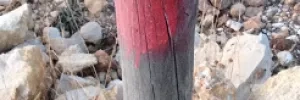
For any of the services in town, turn left when you get to the part pictured above. Follow road straigth to the main road that runs parallel to the camino.
A simple walk through an open landscape. A 500m. dark tunnel may seem a bit frightening, but it is easy and safe walking. So far, the San Olav shares the path with the Vias Verdes, but at Modubar de Emparedada they separate. Pay close attention to the sign at the crossing: San Olav is down to the right.
After 100m. there is a working fountain for filling up your water.

The guide you get from the Tourist Office in Burgos indicates that there is a bar/restaurante and a Casa Rural here. They are all closed down, and it looks permanent.
Pay attention: As you enter town along the via verde, the camino leaves the path for the road. Almost immediately it turns right (see image), and here the signs are difficult to notice. If you miss it and have gone too far down the road, follow the road directions below.
Road Directions: Just follow the asphalt road. There are some ups and downs, but nothing difficult. 2 kms after Emparedada you come to an unmarked T crossing. Turn right. After 300 more m. another crossing, marked Modubar de la Cuesta/Los Ausines. Follow the sign and turn right. You are still on asphalt, but the traffic is insignificant. After a while you arrive at a church shorthly after the top. Leave the road and pass the church, walking down to the village. At the bottom, you will find a friendly bar with real beer from the tap, and food.

Friendly bar with real beer from the tap, and food.
From the bar, you find the gravel road of the San Olav that leads straight to Modubar de San Cibrian, your stay for the first leg of your Camino San Olav. Just go out from the bar and turn left. This is an easy path. Shortly beyond Modubar de la Cuesta, you come to a crossing. Turn right.
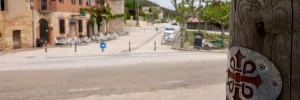
In San Cibrian you find the Casa Rural la Cerca, your stay for the first night. Priced at 30 Euros + food, ca. 15 Euros. Rooms have bathtub. Nice garden. Dinner. You decide what you want to have for dinner in cooperation with the friendly and talkative hostess Mauri Rodrigo. Great company, and good food here. For booking (preferably a day or two in advance), contact Mauri at phone no. 637 853 566.
Real beer from the tap here. A relief.
DO NOT follow the road out of town, it is signed as the Camino del Cid. At the sign shown in the image turn left, and keep an eye open for a right hand turn to parallel the road.
From here, the road is well marked all the way to Covarubbias, with a few exeptions described in this guide.
On your way just out of San Cibrian there is a small sign that is easy to overlook, especially in the dark. Turn right. The same after ca. 1 km. more. So far, the way is wellmarked. Right before Los Ausines you pass a chapel, then it is down to Los Ausines. Upon arrival here, there are no markers. I have spoken about this to the Tourist Office in Covarrubias, who said they would notify the proper authorities to get it fixed. In Los Ausines, there is a non-functional fountain. And nothing more.
Accommodation in Modúbar de San Cibrián
| Casa Rural la Cerca Booking.com |

|

Standing on the paved road after coming down from the chapel, you take left. After ca. 100 m. you pass a sign saying Camino El Cid (shared by the San Olav here), and after 1 km you come to a small café (closed Sunday morning). Continue on the paved road: after a right turn, you enter an endless stretch that leads straight into Revilla del Campo.
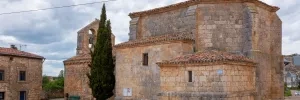
Turn left at the train crossing (where the camino turns right) to get to the Cantina / Bar.
Simple walking, well marked. In Revilla del Campo you follow the signage and take to the right in the crossing inside the village. (If you follow the main road a further 200 m you will come to a friendly bar with sello. Only bottled beer here, unfortunately). Continuing on the camino, after crossing a small bridge, keep to the left through a small village. Here the camino is well marked, and it is flat walking.
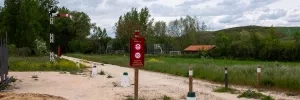
In Quintanalara there is a small bar at the far end of the village, Only bottled beer, unfortunately. Very friendly.
The village has its own multilingual library (!) with an eager librarian. You can sit there and read. The barkeeper will arrange for access for you. The bar is only marked with a San Olav cross + chairs outside. Also a visigothic church.
After the village there is a short ascent, and thereafter flat walking.

This is a small village with a casa rural and bar, unmarked.
You have to actively take right and then left (leave the camino) into the village and ask your way.
The hostess Carmen Heras is the only person I met on these 3 days of walking who could speak rudimentary English. This is the only option for an overnight stay other than the two I used, described in this guide, but you have to call and book well on beforehand, because there is no shop (as always) in the village, and Carmen needs to go to Burgos for shopping before you arrive. Carmen speaks basic English; enough to communicate.
Booking info:
Casa Rural Roblejimeno
c/o Carmen Heras
phone no. 628 692 459
carmenheras@roblejimeno.com
Only canned beer in the bar here, unfortunately. Actually, if the weather is hot (or rainy), it might be a good idea to take a stop here, doing the San Olav in 4 short days in stead of 3.
After a short ascent, you have 1 (short) hour of peaceful, tranquil walking through a forrest on a ridge.
Accommodation in Cubillo del César
| Casa Rural Roblejimeno Booking.com |
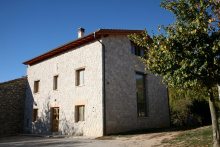
|
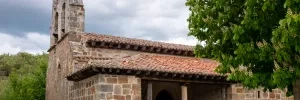
Accommodation in Membrillas de Lara
| Casa Rural Rincon de Alfoz |
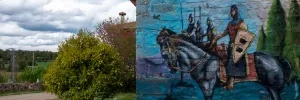
One can have different opinions about the architecture of the chapel of San Olav, but it is really nice on the inside. The couple to the right are Oyvind and Kari, a Norwegian couple who were instrumental in establishing the San Olav Foundation to build the chapel. He is vice president of it and the caretaker of the chapel. They can be reached through the Tourist Office in Covarrubias or their own website.
An easy walk from the chapel to the main road, where you take right to walk into Covarrubias.

On the way into town, ca. 10 mins before, you will find the Hotel Dona Sancha on your right side, which was recommended to me by Kari, and which I higly recommend myself. 33 Euros for a top quality room with a bathtub: Just check in! You enter old Covarrubias through the town gate. To the right inside the gate tower, you will find the tourist office.
In the park outside the Collegiate church is a statue of Kristina. Inside the church is the sarcophagus. Note that it is placed in a separate atrium, behind adoor covered by a red curtain. You need to ask to be let in there, which is no problem at all. This is where Kristina, the ancient Norwegian princess, is sleeping. The Norwegian flag, together with a Spanish one, are honouring the old princess.
EPILOGUE
In Covarrubias, I first ignored Kari's advice to check into the hotel mentioned above. Even if it was September, I had difficulties finding a room inside the city; everything was occupied, so I walked back to the hotel, and they had a fantastic room for me. Book in advance, is my advice. This city is a popular tourist destination. Hotel Dona Sancha, Phone no. 947 406 400.They claim to have a discount for walkers of the San Olav. Prices were 33 Euros for the room; 37 Euros incl. breakfast when I stayed there. But of course, there are many nice and rustic places inside the city walls; feel free to explore and make your own choice.
Return to Burgos will be by bus, which normally leaves from the street outside the city gate at 9.00 AM. Check with the Tourist Office. It is a ca. 40 mins bus ride.
OR
If you like, you can walk on 22–23 kms further south to Santo Domingo do Silos, (Spanish only) famous for its monastery and its singing monks. It is just a good day's walk. And there should be an albergue there, if you need one. Or you can stay in the monastery, I am told. But check it out (in English). From there, the bus leaves for Burgos every morning (check). It is not a part of El Camino San Olav, but since you are in the neighbourhood. I hope this guide has inspired you to take the walk of El Camino San Olav: It is well worth it!
Accommodation in Covarrubias
